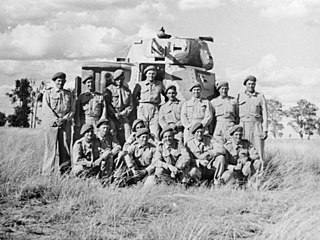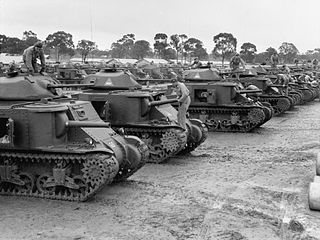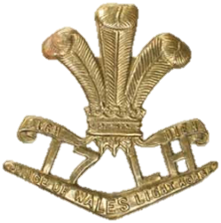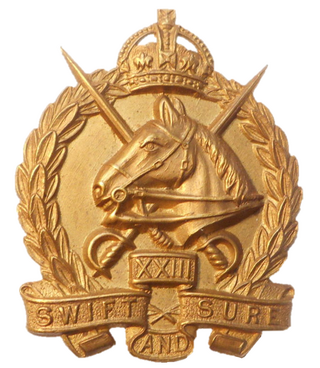
The Royal Australian Armoured Corps (RAAC) is an administrative corps of the Australian Army. It provides the Australian Defence Force's Armour capability, which performs the function of mounted combat. Armour combines firepower, mobility, protection and networked situational awareness to generate shock action and overmatch in close combat. Armour is an essential element of the combined arms approach that is employed by the Australian Army.

The 2nd Armoured Division was an armoured formation of the Australian Army during World War II. Originally raised in 1921 as the 2nd Cavalry Division, based in Victoria and South Australia, the formation had been converted into a motor division in early 1942, before adopting the armoured designation later in the year. A Militia formation, the division undertook garrison duties in Australia and did not see combat before being disbanded in mid-1943.

The 3rd Armoured Division was an armoured unit of the Australian Army during World War II. Originally raised in 1921 as the 1st Cavalry Division, the formation had been converted into a motor division in early 1942, before adopting the armoured designation in November 1942. A Militia formation, the division undertook garrison duties in New South Wales and then Queensland and did not see combat before being disbanded in late 1943 and early 1944.

Armoured units made a relatively small, but important, contribution to Australia’s war effort during World War II. While Australia formed three armoured divisions and two independent armoured brigades during the war, Australian armoured units only saw action as independent regiments and companies supporting larger infantry formations. Early actions were fought in the Middle East by the divisional carrier regiments that supported the 6th, 7th and 9th Divisions, fighting in Libya, Egypt and Syria in 1941–42, before the Australian divisions returned to Australia in 1942–43. During the early fighting in the Pacific, there was a limited role for armoured formations, although one armoured regiment – the 2/6th – took part in the fighting around Buna–Gona in late 1942. Later in the war, though, during the Huon Peninsula, Bougainville and Borneo campaigns of 1943–45, several armoured units were used by Australian forces in the infantry support role.

The 6th Cavalry Brigade was a militia or Citizens Military Force (CMF) formation of the Australian Army based in South Australia. It originated from the 6th Light Horse Brigade and was later converted to the 6th Motor Brigade and eventually to the 6th Armoured Brigade. During World War II, the brigade undertook defensive garrison duties until its conversion to the armoured role in 1942. It did not see combat.

The 1st Armoured Brigade was a formation of the Australian Army during World War II. The brigade was formed in July 1941, at Greta, New South Wales from volunteers for the Second Australian Imperial Force and was assigned to the 1st Armoured Division. Raised initially for service in the Middle East, following Japan's entry into the war, the brigade was assigned to the defence of Australia in case of an invasion. After garrison duties in New South Wales and Western Australia, it was disbanded in November 1944 without seeing active service, although some of its former units saw action later with other formations.

The 2nd Armoured Brigade was a formation of the Australian Army during World War II. The brigade was formed in July 1941, at Puckapunyal, Victoria, from Second Australian Imperial Force volunteers. It was assigned to the 1st Armoured Division in July 1941, with the intention of deploying it to the Middle East. However, it was reassigned to home defence following Japan's entry into the war, and was then transferred to the 3rd Armoured Division in October 1942. The brigade remained in Australia, undertaking defensive duties in Victoria and Queensland before being disbanded in January 1944. While it did not see any active service as a formation, some of its constituent units eventually took part in the campaigns on Tarakan, Labuan, Bougainville and around Aitape–Wewak in 1944–1945 after transferring to other brigades.
The 1st Motor Brigade was a formation of the Australian Army during the interwar years and the early part of World War II. Initially raised in 1921 as the 1st Cavalry Brigade in Queensland, it was a part time formation of the Militia. It consisted of three light horse regiments spread across several depots in the southeast part of the state. During World War II, the brigade was mobilized for defensive duties in December 1941, and assumed positions north of Brisbane to defend against a possible invasion. In early 1942, the brigade was converted into a motorized formation, and was redesignated as the 1st Motor Brigade. In July 1943, when the threat of invasion had passed, it was disbanded and its manpower reallocated to operational formations.
The 2nd Motor Brigade was a formation of the Australian Army during the interwar years and World War II. Initially raised in 1921 as the 2nd Cavalry Brigade in New South Wales, it was a part-time formation of the Militia. It consisted of three light horse regiments spread across several depots across the Hunter Valley and northern part of the state. During World War II, the brigade was mobilised for defensive duties in December 1941, and assumed positions along the northern coast to defend against a possible invasion. In early 1942, the brigade was converted into a motorised formation, and was redesignated as the 2nd Motor Brigade. In April 1943, when the threat of invasion had passed, it was disbanded and its manpower reallocated.
The 3rd Motor Brigade was a formation of the Australian Army during the interwar years and early part of World War II. Initially raised in 1921 as the 3rd Cavalry Brigade in Victoria, it was a formation of the part-time Militia. It consisted of three light horse regiments, which were spread across several depots in regional Victoria. During World War II, the brigade was mobilised for defensive duties in December 1941 to defend against a possible invasion. In early 1942, it was converted into a motorised formation and was redesignated as the 3rd Motor Brigade. The brigade moved to Western Australia in late 1942 and remained there until August 1944 when it was disbanded without having seen combat.

The 4th Motor Brigade was a formation of the Australian Army during the interwar years and the early part of the World War II. A formation of the part-time Militia, the brigade was formed in 1921 as the 4th Cavalry Brigade. At this time, it consisted of three light horse regiments based in southern and western New South Wales. During World War II, the brigade was mobilised for defensive duties in December 1941, and assumed positions along the southern New South Wales coast to defend against a possible invasion. It was converted into the 4th Motor Brigade in March 1942 when it was motorised. As a motor brigade, the 4th undertook defensive duties on the south coast of New South Wales before it was converted into an armoured formation, designated the 3rd Army Tank Brigade in May 1942.
The 5th Motor Brigade was a formation of the Australian Army during the interwar years and World War II. A formation of the part-time Militia, the brigade was formed in 1921 as the 5th Cavalry Brigade. At this time, it consisted of three light horse regiments based in Victoria. The brigade ceased to exist in 1936 due to manpower shortages, but was re-raised during World War II, in April 1942, as a motor brigade. It was quickly disbanded, however, and was used to raise the 6th Armoured Brigade in June 1942, without having seen combat.

The 6th Motor Brigade was a militia formation of the Australian Army, which was formed during World War II. Formed in February 1942 from the previously existing 6th Cavalry Brigade, the brigade undertook defensive duties in Victoria before being converted into an armoured formation in May 1942.

The Australian Army has used tanks from after the First World War, through the interwar period, the Second World War, the Cold War and to the present day. Throughout this period the Army has primarily been a light infantry force, with its tanks mainly being used in the direct support role. The Australian Army's tanks have seen combat during the Second World War and the Vietnam War, where they proved successful despite some of the designs employed being considered obsolete. The first Australian tanks were a small number of British medium and light tanks which were operated mainly for training purposes during the 1920s and 1930s.

The 12th Armoured Regiment was an armoured regiment of the Australian Army, which served during World War II. The regiment was formed in May 1942 as part of the 6th Australian Armoured Brigade. It was originally a Citizens Military Force unit which was converted from the 18th Motor Regiment, formerly the 18th Machine Gun Regiment and previously the 18th Light Horse Regiment.

The 14th Armoured Regiment was a unit of the Australian Army, which served during World War II. The regiment was formed in May 1942 as part of the 6th Australian Armoured Brigade. It was originally a Militia unit which originated from the 17th Light Horse Regiment. It was disbanded in early 1943 without seeing combat.

The 18th Light Horse Regiment (Adelaide Lancers) was a Citizens Military Force unit of the Australian Light Horse, formed during the post-World War I reorganisation of the Australian Army. The regiment traces its origins back to the militia cavalry regiments raised in the colony of South Australia, such as the Adelaide Cavalry Squadron, the Adelaide Mounted Rifles and the South Australian Mounted Rifles. This is a different unit to the pre-World War I, 18th Australian Light Horse (Western Australian Mounted Infantry).

The 17th Light Horse Regiment (Prince of Wale's Light Horse) was a Citizens Military Force (CMF) unit of the Australian Light Horse, formed during the 1912 reorganisation of the Australian Army. The regiment traces its origins back to the militia cavalry regiments raised in the colony of Victoria, such as the Royal Volunteer Cavalry Regiment, the Prince of Wales's Light Horse Hussars and the Sandhurst Cavalry Troop.

The 23rd Light Horse Regiment (Barossa) was a Citizens Military Force (CMF) unit of the Australian Light Horse, formed during the 1912 reorganisation of the Australian Army. The regiment traces its origins back to the militia cavalry units raised in the colony of South Australia, specifically the South Australian Mounted Rifles.

The 20th Pioneer Battalion was an Australian Army pioneer unit that served in New Guinea during World War II. A Militia unit, the battalion was originally formed as a light horse regiment in 1918. Through the 20th Light Horse Regiment, the unit drew lineage back to early Victorian colonial forces, raised in 1885. During the early part of World War II, the unit was converted from a light horse regiment to a motorised unit – the 20th Motor Regiment – and undertook defensive duties in Victoria and then Queensland. In 1944, it deployed in a dismounted role to Merauke in Dutch New Guinea, to defend the Allied airfield that had been constructed there. The unit was later converted into a pioneer battalion in early 1945, deploying to New Guinea in the final stages of the war. It was disbanded in November 1945.















